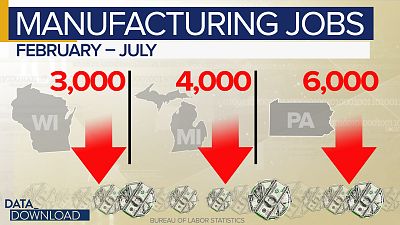New numbers show job creation, GDP and consumer sentiment are lower than previously estimated.
WASHINGTON--Throughout Donald Trump's turbulent presidency, the economy has served as a stabilizer. His economic approval numbers are consistently higher than his overall job approval in polls and he's made his economic stewardship a top reelection talking point. "You have no choice but to vote for me because your 401(k), everything is going to be down the tubes," he told a crowd in New Hampshire earlier this month. "Whether you love me or hate me, you've got to vote for me." But recent headlines and new sets of data are raising questions about exactly where the economy is heading as 2020 approaches. Increasingly it looks like the president's stabilizer is headed for some bumpy times. To start with, it appears some of the nation's good economic times have not been as good as we thought they were. New revised numbers this week from the Bureau of Labor Statistics showed job-creation estimates had been off by about 20 percent. The data showed that about 2 million jobs were created between April 2018 and March 2019. That is 500,000 fewer jobs than the estimates had originally shown. That's not recession territory, of course — growth is growth — but it is not good. And there are similar patterns elsewhere in the numbers. The numbers for Gross Domestic Product were also revised down earlier this year. Another look at GDP earlier this summer from the Commerce Department, showed that U.S. economy grew at a 2.5 percent clip for 2018, rather than the 3.0 number that was first announced. That was a blow to the administration, which had celebrated the 3.0 number as a breakthrough not seen since 2005. The 2.5 number was lower than 2017's 2.8 percent and also below annual figures for 2014 and 2013. Estimates for future GDP growth are lower still. The 2019 estimate is currently at 2.3 percent growth, with the 2020 number at 2.1 percent, according to a new report from the Congressional Budget Office. And this summer has brought fresh concerns about what's coming. The U.S. economy is largely being propelled by consumer spending and August saw a sharp dip in the University of Michigan's Consumer Sentiment Index compared to July. The drop to 92.1 from 98.4 was largely driven by concerns about where the economy was headed, but that "clouds on the horizon" forecast has been driving a lot of the economic unease and not without reason. Some reliable measures for the economy's future health have turned negative in recent weeks. Maybe most concerning for the White House, on Thursday the Purchasing Manger's Index of U.S. manufacturing slipped into contraction territory for the first time in almost a decade. The August measure, 44.9, is just a tick under the number 50, which shows no growth.
To be fair that's a slim difference and that manufacturing number could bounce back in months to come, but the trend over the past few months is unmistakably down. That drop is a special concern to team Trump because of who takes the hit on it. The president ran on a lot of ideas in 2016, but one of the boldest was a promise to reinvigorate manufacturing in the United States. Manufacturing makes up a crucial part of the economies in the three states that ultimately won Trump the presidency: Michigan, Pennsylvania and Wisconsin. And all those states have seen manufacturing employment declines over the last six months. What's going on in all these numbers? Some of this may just be bumps in the road. Even good economic times aren't uniformly good. The global economic slowdown may have something to do with the dips. The United States is not immune from larger global forces. And, of course, the president's trade disputes are likely playing a role. Regardless of the reason, however, these numbers are going to be an important part of the 2020 landscape. Economists and analysts will rightly note that the U.S. economy is still growing, but to some extent, that's beside the point. Much of the economy is psychological. It's less about the numbers than how people feel about the numbers. After months and years of positive trends, an economic slowdown can feel like economic anxiety. That could present a challenge for the president in 2020. Up to now the economy has been the bright spot that Trump could boast because most Americans seemed to feel pretty good about the economy. But these numbers suggest that picture wasn't as sunny as we believed it was and it may be considerably more cloudy in the months ahead.












